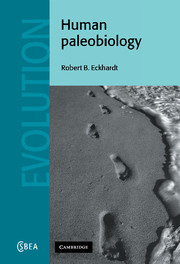Book contents
- Frontmatter
- Contents
- Preface
- Acknowledgments
- 1 Paleobiology: present perspectives on the past
- 2 Constancy and change: taxonomic uncertainty in a probabilistic world
- 3 A century of fossils
- 4 About a century of theory
- 5 Human adaptability present and past
- 6 Primate patterns of diversity and adaptation
- 7 Hominid phylogeny: morphological and molecular measures of diversity
- 8 Plio-Pleistocene hominids: the paleobiology of fragmented populations
- 9 Character state velocity in the emergence of more advanced hominids
- 10 The paleobiology of widely dispersed hominids
- 11 Paleobiological perspectives on modern human origins
- 12 A future for the past
- Bibliography
- Index
3 - A century of fossils
Published online by Cambridge University Press: 18 December 2009
- Frontmatter
- Contents
- Preface
- Acknowledgments
- 1 Paleobiology: present perspectives on the past
- 2 Constancy and change: taxonomic uncertainty in a probabilistic world
- 3 A century of fossils
- 4 About a century of theory
- 5 Human adaptability present and past
- 6 Primate patterns of diversity and adaptation
- 7 Hominid phylogeny: morphological and molecular measures of diversity
- 8 Plio-Pleistocene hominids: the paleobiology of fragmented populations
- 9 Character state velocity in the emergence of more advanced hominids
- 10 The paleobiology of widely dispersed hominids
- 11 Paleobiological perspectives on modern human origins
- 12 A future for the past
- Bibliography
- Index
Summary
Introduction
Paleoanthropology is a challenging subject in modern science, not just because any day can witness the announcement of an important new fossil hominid specimen, but because well over a century of such finds has increased the data base of the field about a thousandfold while leaving many conclusions, ostensibly based on the enlarged body of evidence, relatively unchanged and still in need of reconsideration. Here are a few questions that might be considered of broad interest to anyone interested in evolution. Prior to the divergence of the lineages that led to present day apes and humans, what did our common ancestors look like? When, and under what circumstances, did upright posture evolve? How far back in time did material culture become an integral part of our adaptive repertoire? Is there any way of estimating, in the absence of preserved soft tissues, when diversity in skin, hair, and eye colors arose? When did humans first evolve brains so much larger than would be predicted for primates of our body size?
All of these inquiries about the biology of early humans – human paleobiology – are influenced to some extent by judgments about taxonomic diversity during the evolution of our ancestors over the past five or six million years. However, the debates about taxonomy and phylogeny often loom so large in the field that considerations of more dynamic biological questions are overshadowed. In one relatively recent example, the editors of a symposium volume on species and species concepts in primate evolution concluded that ‘How should nature be carved up into entities called species’ was ‘arguably the most fundamental operational problem in evolutionary biology’ (Kimbel & Martin, 1993).
- Type
- Chapter
- Information
- Human Paleobiology , pp. 40 - 61Publisher: Cambridge University PressPrint publication year: 2000

